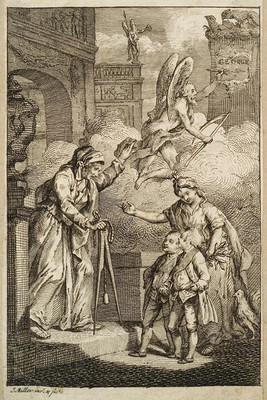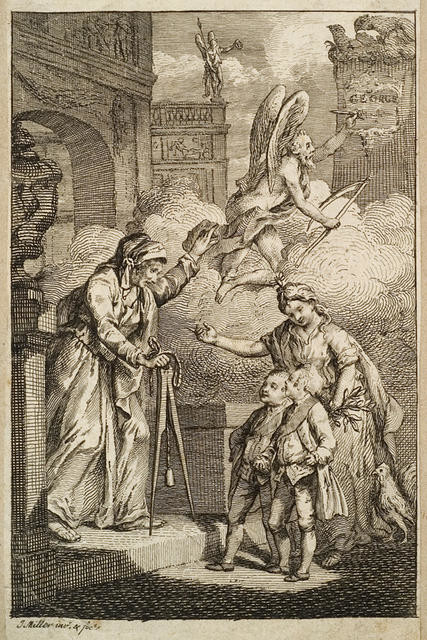B.
Frontispiece to 'Fables amusantes' by Tobias Miller
Collection
This article first appeared in The Press as 'Not so handsome prints with royal stories to tell' on 30 June 2015
Sir Joseph Kinsey (1852-1936) bequeathed his collection of prints to the Robert McDougall Art Gallery and to the Canterbury Museum.
Although these works generally lack the glamour - and certainly the colour - of oil paintings, they all have a decent story to tell.
Researching that story, especially from New Zealand, has always been difficult. Over the last 20 years, the internet has made it a lot easier. Google's ability to search by image, combined with the fact that there are now millions of museum collections and books for Google to work with, has brought us closer to understanding several works from Kinsey's gift.
This print, for example, turns out to be the frontispiece for the 1771 edition of Fables amusantes by John Perrin. French born Perrin moved to Ireland and became an itinerant tutor of the French language and a prolific writer of books for learners of French. Fables amusantes was his own re-writing of the fables of Æsop and La Fontaine, written in very simple French, with explanatory notes and a glossary.
It went through numerous editions and was still in print as late as 1870.
However, the frontispiece has nothing to do with the content of the book, but instead makes reference to the dedication. This is made in typically florid language to George, Prince of Wales, the later George IV (1762-1830). It concludes: "May your Royal Highness live to imitate the character of your royal father, in all those virtues that shine so conspicuous in him!" The frontispiece serves therefore to illustrate the elaborate dedication: George, Prince of Wales and his brother Frederick, Duke of York, are escorted by a figure representing Peace (with olive branch) towards a triumphal arch, where a woman with dividers prepares to measure them against their glorious father.
Father Time (with beard, wings and scythe) inscribes the name, George, on a pedestal where eagles have nested.
In 1771 when the book was first published, the Prince of Wales would have been about 11 years old and the Duke of York (later famous in a song for having gone up and down hills) was about 8.
Their father, George III, had yet to suffer the humiliation of the loss of the American colonies while the triumphs of the Seven Years War (1756-63) would still have been a recent memory. We assume the pedestal will one day bear a statue of either King George the father whose exploits are known, or Prince George the son who may, or may not, measure up to his father.
Tobias Miller, the engraver of this little tableau, was born Tobias Müller in Nuremberg and came to England with his better-known brother Johann Sebastian Muller, later John Miller, in the mid 1740s.
There are many known examples of Tobias Miller's architectural engravings. Nobody is going to pretend this is a great work of art, but it effectively transforms a flamboyant dedication into a single image. An image which Google was able to recognise and match against other copies held in other libraries and museums.

